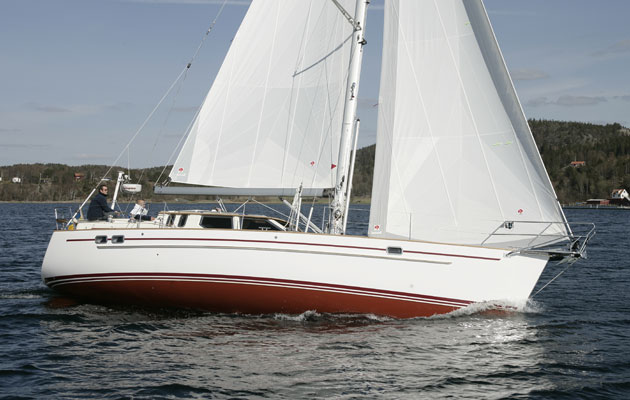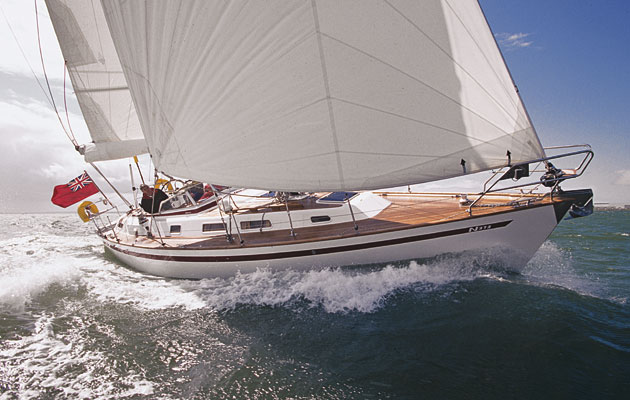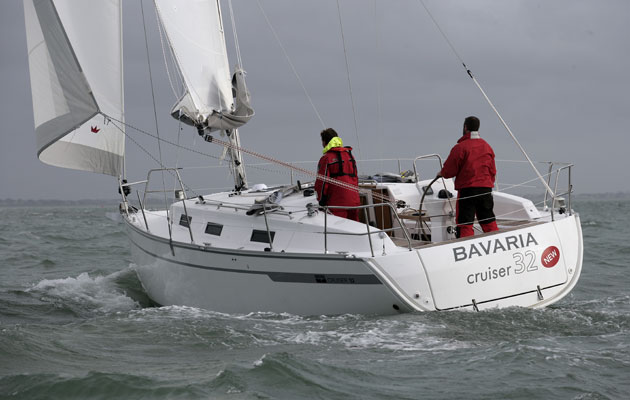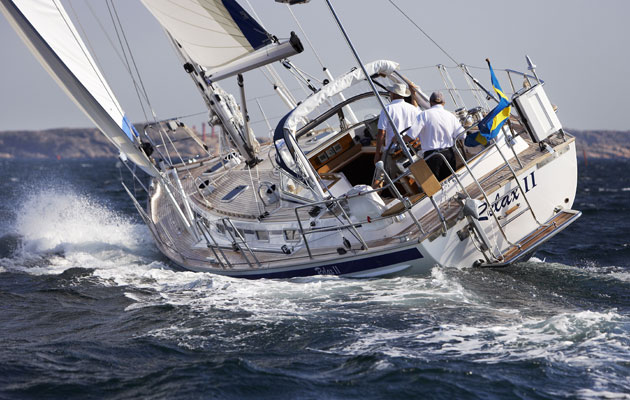Nigel Calder and Chris Beeson explain how to use boat statistics to understand your boat, or choose the right boat for you and your cruising
Understand your boat and her statistics
The perfect cruising boat doesn’t exist and cannot be designed. Different sailors have different budgets and varied experience and requirements. Some coastal cruisers prefer to spend their weekends marina-hopping. Others might prefer to avoid marinas and get away from it all, exploring creeks and quiet anchorages. Some offshore sailors will head across Biscay to the Mediterranean or cross the North Sea to explore the delights of Holland or Scandinavia and the Baltic. Each of these three common types of yacht owner has a completely different idea about what makes the perfect boat.
Marina-hoppers are spoiled for choice. Brokers’ yards are bursting with nippy, spacious, comfortable, well-equipped, good-value cruisers, with fin keels and spade rudders, easy to handle and maintain. Creek crawlers will need a shoal draught yacht that can dry out – one with a skeg rudder and centreboard or bilge keels. The offshore cruiser will need something more bulletproof and more expensive, possibly longer keeled with a skeg rudder – a yacht that can look after herself in a blow without constant attention.
The key to lifelong contentment on the water is to find out what makes your perfect cruiser. There are a huge number of factors to consider and many statistical tools you can use but, before you can find the right answers, you need to ask the right questions.
Desirable attributes

Nigel chose his Malö 46, Nada, after he and wife Terrie took a long hard look at themselves and the way they sail
Everyone has a different cruising style. It’s important to select a boat suited to your aspirations. How and where do you want to sail? Here’s our list of desirable attributes that you can rank in
your own order of importance:
- Speed, on various points of sail
- Comfort, at sea and in harbour
- Short-handed sailing
- Directional stability
- Security in all conditions
- Manoeuvrability under power
- Fun to sail
- Shoal-draught cruising
- Galley specification
- Space for entertaining (saloon and cockpit layout)
You can probably think of some other important factors to add to your personal wish list.
Be honest
Many sailors dream of selling up and sailing to exotic landfalls, sitting on a palm-fringed beach with a rum punch cocktail. But you could spend a fortune on a bulletproof blue water cruiser only for your dreams to fade. For most of us, the reality is coastal cruising in a boat which is typically less expensive, more fun to sail and much more suitable.
With modern weather forecasting and communications, the coastal boat should never be in conditions that can capsize her. This means the design envelope can be pushed towards performance in ways that are not safe for the offshore boat.
The coastal boat will make relatively short passages with the occasional overnighter, whereas the offshore boat will make passages of days or weeks. Once again, the design envelope on the coastal cruiser can be pushed towards performance over comfort. The coastal boat will carry substantially less payload than the offshore boat.
6 key decision-making tools
When it comes to choosing your yacht, you’ll find the published statistics -are very useful decision-making tools, including:
- Displacement/length (D/L) ratio
- Ballast ratio
- Sail area/displacement (SA/D) ratio
- Angle of vanishing stability (AVS, also known as LPS, the limit of positive stability)
- The stability index (STIX) number
- Polar charts
The one problem with these indices is that the boat’s displacement is a key parameter in all of them. In almost all cases the published displacement number, used in the calculations, is the yacht’s ‘light ship’, or unladen weight. For cruising boats, this is unrealistic as the laden weight is much higher. As a general rule of thumb, coastal cruisers should add at least 1,360kg (3,000 lb) to the displacement, and offshore cruisers at least 2,270kg (5,000 lb).
Much of this weight is liquid – water and fuel. You also have batteries, chargers, inverters, calorifiers and other add-ons, a toolbox and spare parts. Don’t forget extra sails and almost certainly a roller furler on the genoa. Then there is the crew and all its kit, plus groceries, a dinghy and its outboard, maybe a liferaft, probably a small but deceptively heavy library. Over time, ‘stuff’ accumulates on almost all boats – when did you last empty yours? – which steadily adds weight in small increments, and this affects every aspect of the boat’s performance.
Remember to account for the actual displacement of your yacht when using the following calculations – for a more detailed explanation, you can refer to Chapter 1 of my Boatowner’s Practical and Technical Cruising Manual. It’s best not to treat your yacht like a shed and load her to the gunwales with paraphernalia you’ll never use, but at the same time don’t imagine that the displacement figures published for your boat or any other are realistic in cruising trim.
1. The Displacement/Length ratio
The equation for working this out is:
D / L = Displacement in lb/ (0.01 x Waterline length in ft)3
Alternatively, you can search online for a ‘displacement length calculator’ and input your yacht’s stats – use imperial or metric, whichever is specified, and be consistent.
The D/L ratio gives a sense of a boat’s speed potential – the lower the number, the faster the boat. The trade-off for speed potential is a lighter boat with a more rapid, less comfortable motion, OK for a coastal cruiser but not nearly so much fun offshore.
Also, if you take a boat with a low D/L ratio and put a cruising payload in her, it will have a proportionately bigger impact on performance than putting the same payload in a boat with a higher D/L ratio.
In the table below, the Rustler 36 looks slow, even as a moderate displacement boat. This is because waterline length is part of the D/L formula, and the Rustler has long overhangs and a short waterline. As soon as she heels, it’s a different story. I’ve put her in here to demonstrate that these performance ratios work best when comparing boats with similar design features, and have to be used with caution where the designs differ significantly. In crude terms, the D/L ratio can be correlated with boat cross-sectional shapes as shown in this graphic.

The performance of lighter boats takes a much greater hit than that of heavier boats, with the same cruising payload
As a general rule, a boat with lower D/L ratio performs better in the light to medium wind range that coastal cruisers enjoy, due to lighter displacement and longer waterline length. In marginal conditions however, Force 6 and above, the lower the D/L ratio, the greater the discomfort upwind – a heavier boat with a well immersed forefoot will not leave the water so readily and so doesn’t slam like a lighter boat.
Also, the lower the D/L ratio, the flatter the bottom and the less volume there is beneath the cabin sole for tankage, which then takes up stowage space beneath the saloon settees and the berths, and the less the bilge volume to accommodate any water that comes aboard. This means it’s more likely that it will end up in the cable runs and lockers when the boat heels. And so on…
I’ve always been an offshore cruiser and 30 years ago most offshore cruising boats had laden D/L ratios well above 400. For example, I estimated that our 39ft Colin Archer double-ender weighed in laden at around 14,515kg (32,000 lb). This gave us a D/L of 436. These boats are real clunkers in terms of sailing capability, but are very safe and secure – we happily cruised with two babies on board. With modern boatbuilding materials and design trends that increase internal volume by removing overhangs, D/L ratios for all types of boats have steadily shifted to lower numbers. For a brand-new coastal cruiser, using published numbers, I would look in the 150 (racer/cruiser) to 250 range, and for an offshore boat, in the 250 (pretty good performance) to 350 range.
If you’re calculating the figures for your boat, is she statistically as lively or sedate as you thought? Have you occasionally wondered if she’s a bit docile for you, or too much of a handful? You might be right. On the flip side, a docile boat requires less intervention and allows you to relax a bit more, while a lively performer rewards your sail trimming and will sail in light winds when others need to fire up their engines.

Boats with a high D/L ratio will give you a smoother ride in the rough stuff. Compare the Rustler 42 (right, D/L 309) to the Bénéteau First 45 (left, D/L 186)
2 The Ballast ratio
The ballast ratio is the percentage of the boat’s weight that is ballast. For example, a boat that displaces 13,608kg (30,000 lb) with a 4,536kg (10,000lb) ballast keel has 33% ballast ratio. If we add a 1,360kg (3,000 lb) coastal cruiser payload to the boat, the gross displacement is now 14,968kg (33,000 lb) and the ballast ratio drops to 30%. The lighter the boat, the greater the impact of payload.
Think of the ballast ratio as a measure of ‘stiffness’ – the resistance to heeling. It’s relevant to short-handed sailing because unlike racing boats, we don’t have five fatties on the rail to increase righting moment when sailing upwind. However, equally important are the ballast’s draught, shape and composition – a boat with a lead bulb on a cast iron fin will be much stiffer than a lead fin keel of identical weight.
There’s also ‘form stability.’ A catamaran, for example, has no ballast but very high form stability thanks to its beam, and the principle also applies to beamy coastal cruisers. Ballast ratio is a rather crude indicator but has its uses.
High performance monohulls may have a ballast ratio approaching 50%. A J-105, for example, has a light ship weight of 3,515kg (7,750 lb), with 1,542kg (3,400 lb) of ballast, for a ballast ratio of 44%. Traditionally, offshore boats have had a ballast ratio of 30-40%. The trend in recent years has been to push more volume into boats, which increases the beam. This, in turn, increases the form stability, reducing the need for ballast to maintain stiffness.
It’s now not uncommon to see ballast ratios below 30%. A Bavaria 40, for example, has a light ship weight of 8,680kg (19,136 lb), with 2,736kg (6,032 lb) of ballast, for a nominal ballast ratio of 31.5%. With a 1,360kg (3,000 lb) coastal cruising payload, this drops to 27%. Despite this low figure, the Bavaria 40, with her extra beam and form stability, is a capable coastal cruiser. For offshore work, I like to have the loaded ballast ratio above 30% (this requires light ship ballast ratios above 35%, increasing to 40% on a weight-and-performance-conscious boat.
As most of us sail short-handed, stiffness is an important factor, so how stiff is your boat? Have you ever thought her a bit tender on the wind? Do you find yourself reefing before anyone else? Maybe your boat has the beam to forgive a low ballast ratio?
3 The Sail Area/Displacement ratio
The equation for working this out is:
SA / D = Sail Area in square feet / (Displacement in cubic feet)2/3
Alternatively, search online for a ‘sail area displacement calculator’ and input your boat’s stats – use imperial or metric, whichever is specified, and be consistent
The SA/D ratio is a measure of the power of the sails relative to the weight of the boat. In this case, the higher the number, the higher the performance, but the harder the boat will be to handle. A SA/D ratio above 20 is getting into the lively performance category. I was once on a custom-built racing boat with a SA/D ratio of 40. She was doing 8 knots in 8 knots of true wind speed. The wind gusted up to 12 knots and the boat was completely out of control.
The SA/D number is significantly affected by adding weight to the boat and by how the sail area itself is measured – it should be measured as the area of the mainsail plus the area of the foretriangle ((I x J) / 2, where I is the distance from the mast boot to the genoa halyard sheave and J is the distance from the mast boot to the forestay tang) or a 100% jib. Many manufacturers quote the area of the sails, and the genoa could be 140% or more of the foretriangle, so the published numbers have to be taken with a substantial grain of salt but we can make some useful generalisations.
For coastal cruising, I’d be looking in the 18 to 24 range, with 24 being very much on the ‘fun to sail’ end of the spectrum, a performance cruiser that rewards tweaking and tuning. On older, heavier cruising boats, the SA/D number was almost always below 16, and often as low as 12. These boats need 12-15 knots of wind to get going and their owners almost always motor if the apparent wind is below 10 knots. My target for a more modern offshore cruising boat is in the 17 to 20 range for published numbers.
The Regina 40, for example, is a solid Swedish offshore cruiser with impeccable sailing manners and extremely safe but a little under- canvassed, is at 15.2; a Westerly Corsair 36 is at 17; a Najad 373, a solid cruising boat with reasonable performance, is at 19; the racy X-40 scores 23.8.
Perhaps you enjoy the cut-and-thrust of the odd Wednesday night race with friends, but you also want some drama-free cruising with the family at the weekend? Don’t forget that you can’t add sail area without spending lots of money, but you can reduce it in seconds by reefing, so it might be best to err on the side of better performance.
4 The Angle of Vanishing Stability

Here we compare the AVS of the traditional, well-ballasted Contessa 32, to the more modern, beamy Bavaria 32
The angle of vanishing stability (AVS) is a measure of how far a boat can heel before she rolls over and inverts – in other words, her resistance to capsize. Before the AVS is reached, the yacht’s centre of gravity (G) is inside its centre of buoyancy (B), creating a positive righting moment (RM). At the AVS, G is directly above B, but once B moves inside G, the yacht has a negative RM and will need an external force, like wave movement, to right. The smaller the area between the inverted curve and the zero axis, the quicker she is likely to right.
Almost all yachts can put the masthead well under water and still not capsize. An AVS of 105 degrees, for example, means the boat can theoretically roll to 105 degrees (with the masthead 15 degrees below horizontal) before capsizing. An AVS of 140 means the masthead can be 50 degrees below horizontal before the boat capsizes. There will be water flooding in through cockpit lockers and any open portholes and hatches, but the boat should right herself. Multihulls are the exception. If they heel to beyond 90 degrees, they roll over, and once upside-down are just as stable as when right side up.
There is another component to the AVS number. The higher the number, the quicker, in theory, the boat will right herself if capsized. With an AVS of 120, if the boat capsizes she should right itself within two minutes. Traditionally, 120 has been taken as the lower limit for cruising boats. However, when I stick my head under water in the bath and hold my breath, I can’t come close to two minutes. I prefer a higher AVS number (the Fastnet Race requires a minimum of 130), but often this translates into heavier, more comfortable, less sprightly boats. These days, numbers as low as 105 are not unknown for coastal cruisers.
The boat’s weight is an important part of the AVS calculation, and more particularly the distribution of the weight. Adding weight higher up lowers the AVS, whereas adding it below the centre of gravity raises it. It is important to remember this when adding stores and gear to boats. Heavy roller-furling or in-mast furling gear will have a significant impact, as will a radar radome or wind generator high on the mast, a large outboard engine hanging on the pushpit, or jerrycans of water and fuel stowed on deck. Ideally, heavy items should be as low down as possible and on the centreline.
After tests conducted for his book Heavy Weather Sailing, Peter Bruce concluded that any yacht will capsize if hit beam-on by a wave higher than half her overall length. Fortunately, with reasonable attention to weather forecasts, coastal cruisers need never encounter waves of that size, so it’s not a big issue, just worth a glance. If you’re planning to spend a lot of time sailing offshore, choose a yacht with a higher AVS. It’s worth noting that the inquiry into the 1979 Fastnet Race found that downflooding with a ton of water makes it easier to right a capsized vessel, and two tons makes it easier still. It seems counter-intuitive, but it’s the same effect that destabilised, then capsized the cross-Channel ferry Herald of Free Enterprise.
5 The STIX number
The AVS calculation is a pretty crude measure of stability. Following the 1979 Fastnet Race, the European Union began work on a much more sophisticated approach that incorporates more measures of stability and also takes account of other important factors, such as the angle of heel at which open portholes and hatches will start to flood the boat.
STIX (short for ‘stability index’) defines four categories of boats. Of interest to us are the ‘A’ (for offshore) and ‘B’ (for coastal) categories. To be classified in the ‘A’ category, boats have to score 32 or higher on the STIX scale. To be classified in the ‘B’ category, the STIX score has to be 23 or higher. My own sense is that Category ‘A’ is not conservative enough. Given that the STIX number is considerably affected by the length of a boat, with longer boats scoring higher numbers, for offshore work I consider a better rule to be as follows: the STIX number should be at least equal to the length of the boat in feet – a 40ft boat should score 40 or higher. My own Malö 46, for example, has a STIX number of 56.
It took over a decade to reach agreement on STIX and there are still some anomalies. Some boats that are universally considered suitable for offshore cruising (some of which have sailed extensively in high latitudes) do not receive an offshore rating, while others that should really be considered coastal boats do get an offshore rating. For example, the Ovni 395 – a proven offshore cruiser – just squeaks into the offshore category at 33.41. Interestingly, she also has a low AVS, at 115 degrees, because of her internal ballast.
6 Velocity Prediction Programs
For years now, most boat design work has been done on computers using sophisticated software. The computer can spit out performance predictions that previously would have taken long hours of tedious calculations. The usual result is a ‘polar diagram’, generated by a velocity prediction program (VPP).
The VPP plots boat speed against true wind speed and true wind angle. It assumes all kinds of things, such as flat water, an optimum suit of sails, and a crew that knows how to sail the boat to her optimum capabilities. In real life, it’s sometimes hard to achieve the same results. Nevertheless, the VPP provides a fair indicator of a boat’s performance.

The polars show that the J-133 is faster all round, especially broad reaching with her spinnaker set. The Malö 43’s chart indicates, literally, a more rounded performance but at lower speeds
According to the VPP-generated polar graph, a J-133 sailing at 135° to 20 knots of true wind, with her gennaker flying, should make 11 knots. Sailing at 45° to a 12-knot breeze, under main and jib, she should make 7.5 knots.
When comparing boats, I like to take the VPP charts, blow them up or down on a photocopier until they are the same size, and then put them on top of each other on a light table. If I was a bit more computer-savvy, I could scan them and do this more effectively with my computer. In any event, you immediately get a sense of which is the better performing boat on different points of sail.
Your horse, for your course

Do you really need the facilities – and expense – of a big blue water-specified boat like this Allures 44?

Or will you actually spend your time pottering around the coast, in which case a bilge-keeled Legend 39 like this suits better
I’ve skimmed over many significant issues on which experienced sailors have strong, differing opinions. At the end of the day, our personal idiosyncrasies are a key part of the relationship we have with our boats. If you can temper yours with the kind of objective data I described at the beginning of this article, you will be able to understand better why your boat behaves the way she does. If you’re looking for a boat, these tools will help you narrow down the search and find the perfect cruiser for you. And who cares what’s perfect for anyone else?
Enjoyed reading this?
A subscription to Yachting Monthly magazine costs around 40% less than the cover price.
Print and digital editions are available through Magazines Direct – where you can also find the latest deals.
YM is packed with information to help you get the most from your time on the water.
- Take your seamanship to the next level with tips, advice and skills from our experts
- Impartial in-depth reviews of the latest yachts and equipment
- Cruising guides to help you reach those dream destinations
Follow us on Facebook, Twitter and Instagram.





















